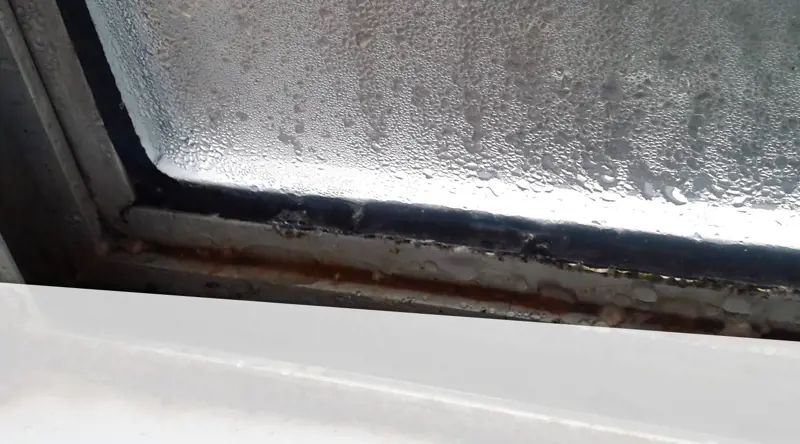
What Causes Window Rot?
One of the most common structural issues for homes is wood rot, especially for homes in areas that experience a lot of rain. Window openings are among the first places wood rot strikes. But what is wood rot? What causes window rot? How can you check for it? And can it be repaired or even prevented? We've got the answers to your questions in this post.
Use the links below to skip ahead:
- What is window rot?
- What causes window rot?
- How do I check for window rot?
- Can window rot be repaired?
- How to prevent wood rot
What is window rot?
Window rot is the breakdown of the wood around the window when certain fungi are present (not your uncle, the fun guy, but the natural kind). There are three types of fungi that cause window rot and they can be spotted in different ways:
- Brown Rot, often called dry rot. It is named this because wood often looks dry and brownish in color. The fungi target cellulose in the wood which then shrinks and forms little cubes, called cubical fracture. When it starts, it spreads rapidly.
- White Rot, or yellow rot. This fungus targets lignin, another compound in wood, and actually leave the white cellulose behind, creating the white color that gives it its name.
- Soft Rot. This type of rot is caused by yet another fungi. It takes longer to rot wood than brown or white rot, but it can grow and thrive in environments that are either too cold or too hot for the other types of rot.
In short, window rot consists of one of three types of fungi-caused decay that causes a break down in the structure of wood.
What causes window rot?
While the underlying cause of window rot is one of the fungi described above, it also is caused by the presence of moisture. None of the fungi above will grow without it. So the structural flaws that result from window rot or wood rot elsewhere in your home are actually caused by another structural flaw that lets moisture into your home and traps it where it should not be.
For example, the caulking around your window frame might leak, and then water will accumulate on either the inside or outside of the sill near or around the glass of the windowpane. The fungi feed on the moisture and cause the wood to break down. While today’s windows are designed not to leak, it only takes a small leak for enough water to get in and start causing damage.
The problem? The more the wood breaks down, the more place there is for moisture to sit, and the more humidity the fungi have to help it grow. This is why brown rot spreads so quickly once it gets started. The rot itself creates better conditions for rot to develop in.
Also, wood that has a high moisture content is more appealing to termites and carpenter ants. Mold can also develop in the wood and the area around it, adding a health risk to you, your family, and your guests.
This is why it is so important to check for window rot often and to prevent it whenever possible.
How do I check for window rot?
If you check for window rot once or twice a year, depending on your climate, that is probably plenty. One of the tell-tale signs of wood rot is how the wood feels. If any of the wood around your windows feels soft or spongy, you probably have some window rot happening. Healthy wood will feel dry and strong.
Also, check for discoloration. Wood that looks like it has shrunk in any way and is brown in color probably has brown rot. Wood that looks white or has small, white streaks showing through the paint is probably experiencing wood rot.
One trick is to carry a nail around with you. If you can press it into the wood without the help of a hammer, especially if the wood feels damp at all, you should take a closer look or have an expert out to inspect the wood. Bringing out an inspector can be a good investment because they'll also help you identify other places where you might have wood rot.
Can window rot be repaired?
Wood that has started to rot, regardless of how far the rot has progressed, must be replaced. There is no reliable way to stop the spread of the rot and restore the wood to its former structural integrity.
In the case of windows, what this usually means is a full window unit replacement including the frame. But be aware: once the frame is removed, you might reveal other wood rot around the area, depending on how long the window has been rotting. The key is early detection so the repair is as simple and efficient as possible.
Depending on your home, you may want to consider a more modern window structure and even different materials for the window frame itself. The best policy? Consult a window replacement specialist to determine what the best answer for your home is.
4 ways to prevent wood rot
Like many other things, an ounce of prevention is worth a pound of cure, and that means you need to be proactive. Here are four things you can do to prevent wood rot:
- Make sure the finish on your windows is in good condition, especially on wood windows. Water can penetrate the finish on wood windows and can work its way behind cladding so make sure it is always in good condition to prevent water damage.
- Check windows, doors, and other entry points to your home regularly. Wherever water can accumulate and get into wood should be inspected at least twice a year.
- Repair any leaks right away. If you get window fogging, window leaks, moisture on window ledges inside or out, or water accumulating around window sashes, replace or repair the caulk or seals in that area. If something cannot be repaired, replace it as soon as possible.
- If you have doubts, have it checked out. Similar to your personal health, the health of your home depends on a lot of things, so if you even suspect something might be going on with your home, have it professionally inspected, especially when it comes to leaks, moisture, and potential structural damage.
Wood rot and specifically window rot in your home can be prevented. But in the case that you actually have wood rot already, get it repaired right away. Complete window unit replacements are the way to go, as you can never restore wood that has started to rot to its original strength.
The sooner you catch window rot, the better. Fixing things right away will prevent further damage elsewhere in your home, the development of mold and other hazards, and the invasion of pests.
Oops!
We don't currently serve your area but do want to help you plan your project. Try our Build & Price tool to get an idea of window & door costs within DFW. Your area may be higher or lower but at least you'll have some idea of the price.
Thanks for stopping by.







